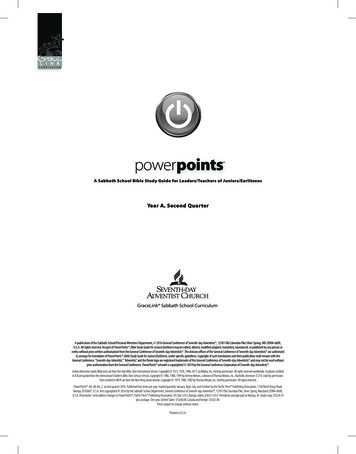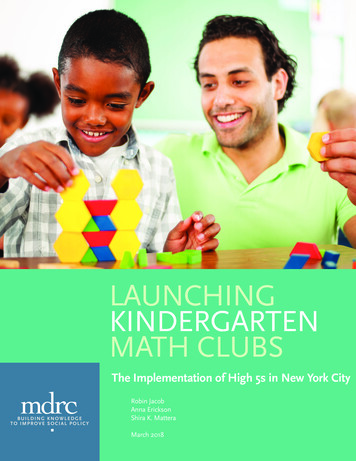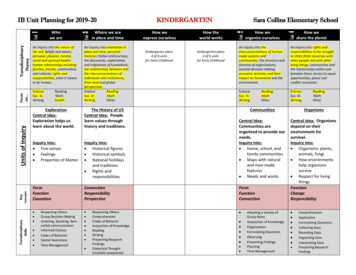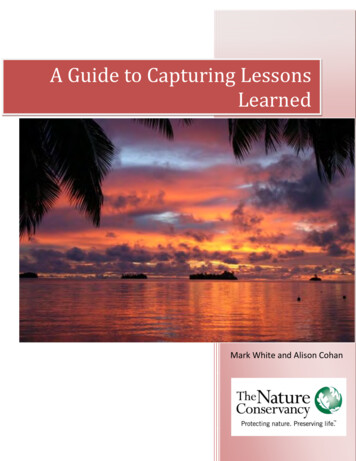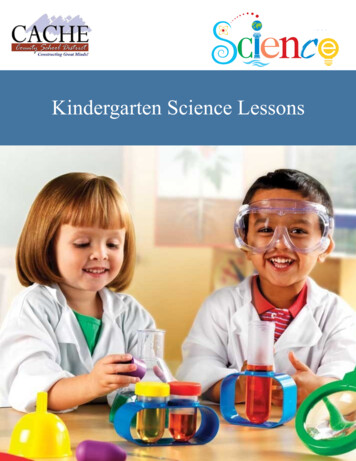
Transcription
Kindergarten Science Lessons
KindergartenTEACHER SCIENCE LESSON & RESOURCE GUIDECache County School District
1
CONTENTSCORE STANDARDS OF THE COURSE .4Lesson Collections .7S1O1 - A Drop in the Bucket - USU Water Cycle .8S1O1, S1O2, S1O3 - Build A Bug - Bugs Don’t Bug Me . 11S1O1- Exploring Science Tools . 14S1O1, S1O2, S1O3 - If Bugs Could Talk - Bugs Don’t Bug Me . 16S1O1, S1O2, S1O3 - Macroinvertebrate Graphing Activity - Bugs Don’t Bug Me. 20S1O1, S1O2 - Macroinvertebrate Investigation - Bugs Don’t Bug Me . 23S1O1- Macroinvertebrate Simon Says - Bugs Don’t Bug Me . 26S1O1- Non-Standard Measurement Skills. 28S1O1, S1O2, S1O3 - Water Pollution Graphing - Bugs Don’t Bug Me . 30S1O2, S1O3 - Macroinvertebrate Mix and Match - Bugs Don’t Bug Me . 34S2O1- It “Sort”of Matters Where Things Go. 37S2O1, S4O2 - Sense of Taste, Hearing, Smell and Touch. 42S1O2, S1O3 - The Incredible Journey - USU Water Cycle . 45S1O2 - Water Cycle Drama - USU Water Cycle . 48S1O2 - Water Cycle Relay Race - USU Water Cycle . 50S2O1, S2O2, S2O3, S4O2 - Spring Nature Walk . 53S2O3 - Cultural Lit. 1: Identifying the Seasons . 55S2O3 - Cultural Lit. 2: Identifying Weather Conditions. 58S2O3 - Dressing for the Season . 60S2O3 - Experiencing the Weather . 63S2O3 - Exploring the Seasons . 70S2O3, S4O2 - Five Senses and Four Seasons Quilt . 77S2O3, Forecasting Through Senses . 80S2O3 - I Can See and Feel the Change in the Seasons . 85S2O3 - K-Act.2O: Favorite Season Circle Graph . 88S2O3 - K-Act.21: Claude Monet Seasonal Painting . 91S2O3 - K-Act.22: Outdoor Observation . 94S2O3 - K-Act.23: Four Seasons Class Mural . 97S2O3 - Seasons . 99S2O1, S2O2, S2O3, S4O2 - Spring Nature Walk . 102S2O3 - Staying Healthy Year Round. 104S2O3 - The Incredible Journey - USU Water Cycle . 1062
S2O3 - Weather Walks . 109S3O1- Let’s Get Moving . 115S3O2 - Everything Has Parts . 118S4O1- Cultural Lit. 3: Identifying Seasonal Animal Behaviors . 123S4O1, S4O2 - Hide & Seek Butterflies . 125S4O1- How Does a Penguin Stay Warm? . 129S4O1- Act.25: Animal Growth Journal . 132S4O1- K-Act. 26: Animal Research and Report . 135S4O1- K-Act. 27: Animal Track Mural . 138S4O1- Pets - Stuffed Animal Day. 140S1O1, S4O1- Washing Hands . 143S4O2 - Animal Classification . 146S4O2 - Animal Coverings . 148S4O2 - Animal Movements . 151S4O2 - Ants . 154S4O2 - Bug Hunt . 157S4O2 - Camp Paws and Claws & Farm Animals . 161S4O2 - Can You Do It? I Can Do It! . 165S4O2 - Exploring Color and the Sense of Sight . 168S4O2 - I Can “Sense” That We are in for a Sense-Ational Experience . 171S4O2 - Let’s Take “Part” in the Study of Animals . 176S4O2 - Picking Apart Plants . 181SCIENCE & STEM RESOURCES . 1843
CORE STANDARDS OF THE COURSEStandard 1The Processes of Science, Communication of Science, and the Nature of Science. Students will be able to apply scientificprocesses, communicate scientific ideas effectively, and understand the nature of science.Objective 1Generating Evidence: Using the processes of scientific investigation (i.e. framing questions, designing investigations, conductinginvestigations, collecting data, drawing conclusions)a.Framing questions: Observe using senses, create a hypothesis, and focus a question that can lead to an investigation.b.Designing investigations: Consider reasons that support ideas, identify ways to gather information that could test ideas,design fair tests, share designs with peers for input and refinement.c.Conducting investigations: Observe, manipulate, measure, describe.d.Collecting data: Deciding what data to collect and how to organize, record, and manipulate the data.e.Drawing conclusions: Analyzing data, making conclusions connected to the data or the evidence gathered, identifyinglimitations or conclusions, identifying future questions to investigate.Objective 2Communicating Science: Communicating effectively using science language and reasoninga.Developing social interaction skills with peers.b.Sharing ideas with peers.c.Connecting ideas with reasons (evidence).d.Using multiple methods of communicating reasons/evidence (verbal, charts, graphs).Objective 3Knowing in Science: Understanding the nature of sciencea.Ideas are supported by reasons.b.There are limits to ideas in science (i.e. what can be observed, measured, and verified).c.Differences in conclusions are best settled through additional observations and investigations.d.Communication of ideas in science is important for helping to check the reasons for ideas.Standard 2Earth and Space Science. Students will gain an understanding of Earth and Space Science through the study of earth materials,celestial movement, and weather.Objective 1Investigate non‐living things.Supplemental Materials (pdf)a.Observe and record that big rocks break down into small rocks, e.g., boulders, rocks, pebbles, sand.4
b.Demonstrate how water and wind move nonliving things.c.Sort, group, and classify Earth materials, e.g., hard, smooth, rough, shiny, flat.Objective 2Observe and describe changes in day and night.Supplemental Materials (pdf)a.Compare and contrast light and dark in a day/night cycle and identify the changes as a pattern.b.Investigate, interpret, and explain to others that the sun provides heat and light to Earth.c.Examine what happens when you block the sun’s light. Explore shadows and temperature changes.Objective 3Compare changes in weather over time.Supplemental Materials (pdf)a.Observe and record that weather changes occur from day‐to‐day and weather patterns occur from season to season.b.Communicate ways weather can affect individuals.c.Describe, predict, and discuss daily weather conditions and how predicting the weather can improve our lives.Standard 3Physical Science. Students will gain an understanding of Physical Science through the study of the forces of motion and theproperties of materials.Objective 1Identify how non‐living things move.Supplemental Materials (pdf)a.Observe and record how objects move in different ways, e.g., fast, slow, zigzag, round and round, up and down,straight line, back and forth, slide, roll, bounce, spin, swing, float, and glide.b.Compare and contrast how physical properties of objects affect their movement, e.g., hard, soft, feathered, round,square, cone, geometric shapes.Objective 2Describe parts of non‐living things.Supplemental Materials (pdf)a.Describe how parts are used to build things and how things can be taken apart.b.Explain why things may not work the same if some of the parts are missing.Standard 4Life Science. Students will gain an understanding of Life Science through the study of changes in organisms over time and thenature of living things.5
Objective 1Investigate living things.Supplemental Materials (pdf)a.Construct questions, give reasons, and share findings about all living things.b.Compare and contrast young plants and animals with their parents.c.Describe some changes in plants and animals that are so slow or so fast that they are hard to see (e.g., seasonalchange, “fast” blooming flower, slow growth, hatching egg).Objective 2Describe the parts of living things.Supplemental Materials (pdf)a.Differentiate between the five senses and related body parts.b.Identify major parts of plants, e.g., roots, stem, leaf, flower, trunk, branches.c.Compare the parts of different animals, e.g., skin, fur, feathers, scales; hand, wing, flipper, fin.6
LESSON COLLECTIONS7
S1O1- A DROP IN THE BUCKET-USU WATER CYCLESummary:Through a visual presentation, the students will learn the different sources of freshwater, and the relative ratios of these watersources on the earth.Time Frame: 1 class period that runs 15 minutesMain Curriculum Tie:Science - KindergartenStandard 1 Objective 1Generating Evidence: Using the processes of scientific investigation (i.e. framing questions, designing investigations, conductinginvestigations, collecting data, drawing conclusions)Materials: Map of world or globe 5-gallon water container Measuring cups Eye dropper 5 gallons of water Small, clear container Water distribution worksheet (pdf)Attachments water-distribution.pdfBackground for Teachers:Approximately 75% of the earth is covered with water. Sources of water are oceans, icecaps and glaciers, groundwater,freshwater lakes, inland seas and salt lakes, the atmosphere, and rivers. Although the earth appears to have a plentiful supply ofwater, it is important to realize that fresh water is a limited resource. See the table below for the percentage of each watersource in relation to the total amount, and the appropriate measurement for each source.Not all of the freshwater is available for humans to use. Water in the atmosphere and in the icecaps and glaciers is not availablefor humans to use. We also cannot access all the groundwater. Therefore, only the water in rivers, freshwater lakes and aportion of groundwater can be used by humans. The percentage of usable freshwater is reduced by pollution and contamination.Therefore, the actual amount of water that is useable by humans is very small (approximately .00003 %).8
Water Source% of the Total AmountMeasurementOceans97.2%All water left in bucketIcecaps/Glaciers2.0%1 CupGroundwater0.62%1/3 CupFreshwater Lakes0.009%1/8 teaspoonInland Seas/Salt Lake0.008%1/8 teaspoonAtmosphere0.001%One dropRivers0.0001%One flickAttachments glossary.pdfdiscussion.pdfDiscussion QuestionsInstructional Procedures:PROCEDURE:1.2.3.4.5.6.Show students the globe or map of the world and ask them what the blue represents (water). Ask them what percentage iscovered by water (75%). Ask the students if all the water is available for humans to use.Show the students the 5 gallons of water in the container. Explain that the 5 gallons represents all the water on the earth.Ask the students to think about the different places we find water. In what area do we find the majority of the water on earth(oceans). Tell them that because the majority of the water is in the ocean, we will leave that water in the bucket. We will betaking out all the water that is from a source other than the ocean.Ask students to name sources of water. As they give you answers, remove the correct amount of water for the area (refer tochart in the background section), and place it into the clear container.After you have removed all the different water sources (other than oceans), ask the students if all the water you haveremoved is usable by humans.Discuss the sources, and put the water back into the bucket with the ocean water if it is not usable by humans(icecaps/glaciers, some of the groundwater, inland seas/salt lakes and the atmosphere). Show the students the smallamount of water that is left for humans to use.WRAP-UP:Review the sources of freshwater on the earth, and how little water is available for human use. Discuss ways students canconserve water in their homes, schools, and communities. Don’t leave the water running while brushing your teeth. Limit your showers to 10 minutes or less. Look around your house for leaky faucets and ask your parents to fix them. Keep a pitcher of water in the refrigerator so you don’t have to run the faucet and wait for the water to cool. Clean your sidewalks with a broom, not a hose. Wash your car or dog on the lawn instead of the driveway, this way your lawn gets watered too. Only wash full loads of dishes and laundry.9
Discuss ways students can help reduce pollution to the already small amount of water available to humans. Don’t use excessive amounts of fertilizers or pesticides around your house. They can wash into the storm drains and endup in a stream. Never put something down a storm drain that may hurt a fish. Don’t be a litterbug. Always dispose of trash in a proper container, not in the water. Make sure that your family car doesn’t leak oil or antifreeze. This can wash into the water and be dangerous for fish,birds, even cats and dogs. Walk only on existing trails when near the water to help reduce erosion.Extensions: Hand out copies of the worksheet to have students fill in the percentage they think is in each location before goingthrough it as a class. They can work in groups or individually. Ask the students if we can make more water. Discuss the water cycle (this can lead into the Incredible Journey lesson). Talk about how pollutants or contaminants would affect our water supply (this can lead into the Water Quality andAquatic Macroinvertebrates lesson).Activities:These activities can be used to enhance or reinforce concepts and vocabulary words learned in the preceding lessons. Drip's Journey (pdf)Word Search (pdf)Song (pdf)Crossword (pdf)Bibliography:This lesson plan was developed by the Utah State University Water Quality Extension.*Adapted from the “Drop in a Bucket” lesson found in Project WET (www.projectwet.org).Author:Utah LessonPlans10
S1O1, S102, S1O3-BUILD A BUG-BUGS DON’T BUG MESummary:By watching a presentation where one of their classmates is dressed up in a bug costume, students learn what adaptationsmacroinvertebrates have in order to live in an aquatic environment.Time Frame: 1 class period that runs 15 minutesMain Curriculum Tie:Science - KindergartenStandard 1 Objective 1Generating Evidence: Using the processes of scientific investigation (i.e. framing questions, designing investigations, conductinginvestigations, collecting data, drawing conclusions)Standard 1 Objective 2Communicating Science: Communicating effectively using science language and reasoningStandard 1 Objective 3Knowing in Science: Understanding the nature of scienceMaterials:Items contained in the “Items Representing Adaptations for Build A Bug” column in Appendix C (pdf). Use your imagination!Bright colors and silly items work well.Background for Teachers:PURPOSE:To introduce students to aquatic macroinvertebrates and their unique adaptations.BACKGROUND:The small animals that live in water are called aquatic macroinvertebrates. These macroinvertebrates include many types ofinsects as well as other animals such as worms, mollusks, and crustaceans.11
Most aquatic macroinvertebrates make their home in rocks, leaves, and the sediment of streambeds. These organisms havemany special adaptations that allow them to live in demanding environments. Macroinvertebrates that live in riffles and fastmoving water may have features that help them hold on to rocky or hard substrates such as hooked feet or suction cups; or flat,streamlined bodies that can handle high water velocity. Macroinvertebrates that house themselves deep in muddy substratesmay have different sets of adaptations for low oxygen environments, such as air tubes or oxygen trapping red hemoglobin intheir tissue. See the “Adaptations” column in Appendix C (pdf) for more examples.Attachments appendix-c.pdfdiscussion.pdfDiscussion Questionsglossary.pdfintroduction.pdfInstructional Procedures:PROCEDURE:1.2.3.4.5.Ask the students to brainstorm different adaptations a bug would need to live in an aquatic environment. (For youngerstudents you may want to start with what an adaptation is.)As students give you ideas, show pictures of invertebrates with these adaptations (see Appendix B (pdf)).Choose a volunteer from the class. Explain that you will be preparing the student to live as an aquatic macroinvertebrate.Ask the students to recall adaptations the volunteer needs in order to live in water.As students give you ideas, dress the volunteer in the items from the table in Appendix C (pdf) that represent theadaptations.NOTE: An individual macroinvertebrate may not have all of the adaptations listed on the table. Your volunteer “bug” will havefeatures found on many different types of macroinvertebrates.6.7.Discuss the adaptations as you go along. Why would a macroinvertebrate need them? How do they help themacroinvertebrate survive?A good way to end this activity is with a photo. “Does our volunteer need anything else? I think he/she needs his/her picturetaken!”OPTIONAL ART ACTIVITY:You can enhance this lesson with the following art activity (use the materials listed inthe table in Appendix C).1.2.3.4.5.Tell your students that they will be making an aquatic macroinvertebrate of theirown.Show the students the materials listed in the adaptations table of Appendix C, (orsubstitute other materials to represent adaptations as you see fit).Ask them to recall adaptations they saw during the lesson and show them whatmaterials might represent that adaptation (a feather might represent gills,bendaroos might represent legs and/or tails, etc.).Have students use the materials to create their own macroinvertebrateHave each student share his or her macroinvertebrate with the class and explain the adaptations.Attachments appendix-b.pdfbuild-bug.jpg12
Extensions:This lesson can be followed with Macroinvertebrate Simon Says to teach about specific feeding adaptations. You can also followthis lesson with Macroinvertebrate Mix and Match to teach the three parts of a bug.Bibliography:This lesson plan was developed by the Utah State University Water Quality Extension.Author:Utah LessonPlans13
S1O1-EXPLORING SCIENCE TOOLSSummary:Students use a balance and make predictions about heavier and lighter objects. Students also use a graduated cylinder andcompare how the same volume of water looks to be a different amount when poured into different sized containers. Datarecording could be done in a large group setting with an adult facilitator or with helpers at each station.Time Frame: 1 class period that runs 45 minutesMain Curriculum Tie:Science - KindergartenStandard 1 Objective 1Generating Evidence: Using the processes of scientific investigation (i.e. framing questions, designing investigations, conductinginvestigations, collecting data, drawing conclusions)Materials: One balance per group of students. 1 g mass cubes from enasco.com TB16755M Set of 500 for 12.50. Assorted objects to measure mass. About 15 – 20 objects per group and it is easiest to make them all the same objectsfor each group. One 100 ml graduated cylinder per student, if possible. If not, students can share them in groups. These can bepurchased in plastic from many different vendors. Carolina.com 721613 1.90 each. 500 ml Wash bottles, one per student, if possible. If not, students can share them in groups. Carolina.com 716594. 4.45each. May be cheaper from other vendors. 6-10 different plastic containers per group. Make them different sizes in height and width. 1 bucket per group to put the waste water in.Attachments exploringsciencetoolsdatasheet.pdfExploring Science Tools Data SheetBackground for Teachers:Students need to become comfortable using science tools. In this lab, a balance, wash bottle (squeezable bottle with a straw)and graduated cylinder will be introduced. Students will make many different predictions during the lab. It is critical that studentslearn at the earliest age that making predictions is not a right and wrong process and incorrect answers are acceptable. Thisneeds to be reinforced constantly14
Intended Learning Outcomes:1.2.3.Framing questions. Conducting investigations. Collecting data. Drawing conclusions.Developing social interaction skills with peers. Sharing ideas with peers. Connecting ideas with reasons.Ideas are supported by reasons. Communication of ideas in science is important for helping to check the reasons for ideas.Instructional Procedures:Pre-lab Discussion:Ask the students if they are scientists. Tell them they are and scientists need to learn how to use science tools. Show them thebalance and graduated cylinder and go over the names with them. Talk to students about what a prediction is and that there areno wrong predictions in science.Instructional Procedures:Using a balance: This activity is done at each table as a group.1.2.3.Show the students a balance and have them predict how it works.Have students take turns picking up two objects and testing them in their hands. They should predict which is heavier andthen try it out on the balance. Be sure that students are put at ease when their predictions are incorrect.After a couple of turns at this, have the students as a group, measure the mass of an object using the balance and gramcubes.Using a Graduated Cylinder:1.2.3.4.Discuss the purpose of measuring liquids in a science lab.Ask the students to measure different amounts of water in units of 10. Students can use a wash bottle to fill the graduatedcylinder to the designated amounts.After they measure, they can transfer the liquid to different size containers and observe that the same amount of liquid looksdifferent in different shaped containers. Have them predict what will happen as they transfer the liquids from container tocontainer.Students can empty their container of water into a bucket and then measure a new volume and pour it into a differentcontainer.Bibliography:Rio Tinto Hands-on Science Curriculum Team Ms. Rae Louie – Administrator, Principal Beacon Heights Elementary Emily Mortensen – Grant writer, teacher outreach, 2nd grade teacher at Beacon Heights Elementary Ruth Li – Curriculum design, K-6 Science Educator at Indian Hills Elementary Deirdre Straight – Curriculum development, K-6 Science Educator at Beacon Heights Elementary Tim Rausch – Website development, Library Media at Beacon Heights ElementaryAuthor:Utah LessonPlans15
S1O1, S102, S1O3-IF BUGS COULD TALK-BUGS DON’T BUG MESummary:Students will evaluate the quality of a “water sample” (using a bag of skittles to represent pollution and pictures of aquaticmacroinvertebrates to represent invertebrates found in their sample), graph their results, and form a hypothesis about the landuse near the location their “water sample” was collected.Time Frame: 1 class period that runs 30 minutesMain Curriculum Tie:Science - KindergartenStandard 1 Objective 1Generating Evidence: Using the processes of scientific investigation (i.e. framing questions, designing investigations, conductinginvestigations, collecting data, drawing conclusions)Standard 1 Objective 2Communicating Science: Communicating effectively using science language and reasoningStandard 1 Objective 3Knowing in Science: Understanding the nature of scienceMaterials: Candy (skittles) Plastic sandwich bags Graph paper (graphs can be found in Appendix D (pdf)) Colored pencils Pollutant labels (see Appendix D (pdf))Macroinvertebrate pictures (see Appendix D (pdf))Attachments appendix-d.pdfBackground for Teachers:PURPOSE:To describe and identify the link between land use activities within a watershed and water quality. Students will also understandthe link between aquatic macroinvertebrates and water pollution.BACKGROUND:A watershed is an area of land from which all the water drains to the same location such as a stream, pond, lake, river, wetland,or estuary. A watershed can be large, like the Colorado River drainage basin, or very small, such as all the water that drains to asmall farm pond. Large watersheds are often called basins and contain many small watersheds.16
Watersheds can transport non-point source pollution. Non-point source pollution is associated with rainfall and snowmelt runoffmoving over and through the ground, carrying natural and human made pollutants into water sources. Examples of non-pointsource pollutants are fertilizers, pesticides, sediment, gas, and oil. Pollutants accumulate in watersheds as a result of varioushuman driven and natural events. These pollutants, while sometimes inevitable, drastically alter the state of the ecosystem. If wecan determine the type of pollutant and its cause, then we can classify the source of the pollutant and take preventativemeasures to reduce any further contaminants. Below are some examples of land use and their potential problems:NOTE: These problems only occur because of a lack of proper management.Land UseActivitiesPotential Pollution
Physical Science. Students will gain an understanding of Physical Science through the study of the forces of motion and the properties of materials. Objective 1 Identify how non‐living things move. Supplemental Materials (pdf) a. Observe and record how objects move in different ways



